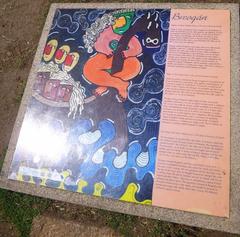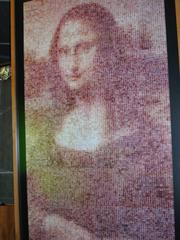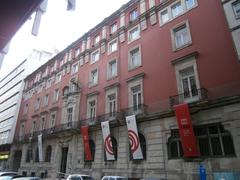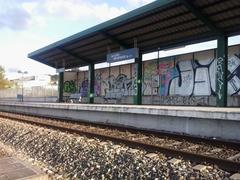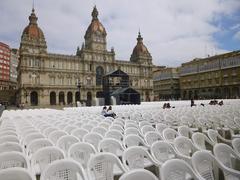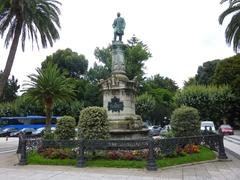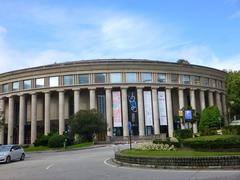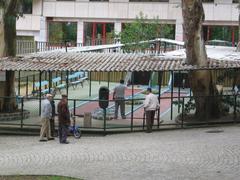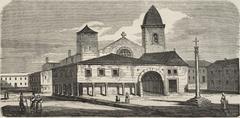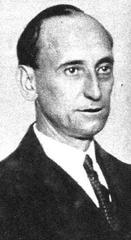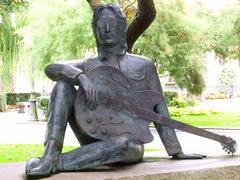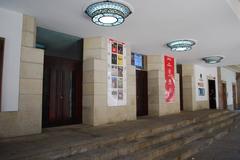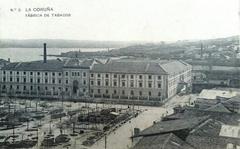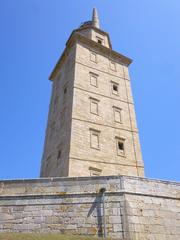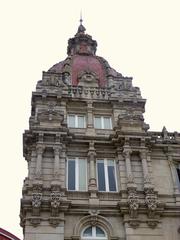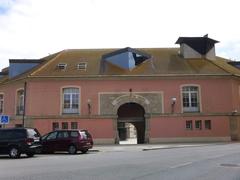
Cuartel Da Mestranza Da Coruña: Visiting Hours, Tickets, and Historical Sites Guide
Date: 04/07/2025
Introduction
Situated in the historic heart of A Coruña, Spain, the Cuartel Da Mestranza Da Coruña is a distinguished monument reflecting the city’s military legacy and architectural evolution. Originally built in the late 18th century as an artillery barracks, this neoclassical structure played a vital role in the defense of the Galician coast and Spain’s broader naval strategy. Today, it serves as both a preserved heritage landmark and the seat of the Rectorate of the University of A Coruña, symbolizing the city’s harmonious blend of tradition and modernity. This comprehensive guide provides everything you need to know about visiting the Cuartel Da Mestranza, including up-to-date visiting hours, admission policies, accessibility, nearby attractions, and travel tips to ensure a rewarding visit. For official updates, consult resources like the University of A Coruña, the Galicia Guide, and the A Coruña Tourism Office.
Table of Contents
- Origins and Early History
- Military Significance and Strategic Role
- Architectural Features and Evolution
- Transition to Civilian Use and Modern Significance
- Visiting Information (Hours, Tickets, Accessibility)
- Travel Tips and Nearby Attractions
- Cultural and Historical Legacy
- Key Dates and Milestones
- Preservation and Urban Context
- Frequently Asked Questions (FAQ)
- Sources and Further Reading
Origins and Early History
The Cuartel Da Mestranza Da Coruña dates back to Spain’s military expansion in the late 18th and early 19th centuries. “Mestranza” referred to the arsenal responsible for storage and maintenance of military equipment—a crucial function for a city on the Atlantic frontier (Galicia Guide). The site’s strategic location near the port and city walls highlights A Coruña’s longstanding role as both a military stronghold and maritime hub.
The area has held military significance since Roman times, originally known as Brigantia. Its proximity to other defensive sites, such as Castillo de San Antón and the Campo da Estrada, underscores its importance in the city’s defensive network (Galicia Guide).
Military Significance and Strategic Role
Throughout the 19th century, the Cuartel Da Mestranza was pivotal in the city’s defense. It supported Spanish naval expeditions and housed troops essential to A Coruña’s fortifications. The barracks played a logistical role during conflicts such as the Peninsular War (1807–1814), when A Coruña became a key base for allied British and Spanish forces (Galicia Guide).
Notably, the city’s defenses—including the Cuartel—were strengthened after the 1589 attack by Sir Francis Drake, reinforcing the need for robust coastal fortifications (Galicia Guide).
Architectural Features and Evolution
Layout and Construction
The Cuartel Da Mestranza features an irregular hexagonal shape enclosing a central, porticoed courtyard—a design attributed to military engineer Baltasar Ricaud in 1771 (La Voz de Galicia). Built from local granite, the structure displays neoclassical symmetry, robust stonework, and restrained ornamentation typical of Enlightenment-era military architecture.
Adaptive Reuse
After centuries as a military complex—including roles as arsenal, forge, and training ground—the Cuartel was rehabilitated in 1994 to house the Rectorate and Paraninfo of the University of A Coruña. The restoration preserved the historical layout while introducing modern amenities and accessibility features (La Voz de Galicia).
Artistic and Memorial Elements
The grounds feature sculptures such as Francisco Asorey’s monument to the soldier, while architectural details like porticoed galleries and granite cornices highlight local craftsmanship (Wikipedia - Cuartel de Atocha).
Transition to Civilian Use and Modern Significance
As military needs changed in the 20th century, the Cuartel Da Mestranza transitioned to new functions. Its conversion into a university facility reflects a broader trend of adaptive reuse in Spanish cities, preserving heritage while supporting contemporary civic life (Xornal da Coruña). The adjacent Campo da Estrada, once used for military drills, now hosts equestrian and sporting events, integrating the site into the city’s vibrant community life.
Visiting Cuartel Da Mestranza Da Coruña: Hours, Tickets, and Accessibility
Visiting Hours
- Gardens (Jardines de la Mestranza): Open daily, dawn to dusk, free of charge.
- Building Interior: Public access is limited as the building houses the university’s rectorate. Interior visits are usually available during special events or guided tours. Always check the University of A Coruña or A Coruña Tourist Office for up-to-date schedules.
Tickets and Admission
- Gardens: Free entry.
- Guided Tours: Special tours and events may require advance booking and a nominal fee (typically around €5 per person). Confirm details with the university or tourist office.
Accessibility
- The gardens are accessible to visitors with mobility needs.
- Building interiors include ramps and elevators, but some historic areas may remain challenging. Contact the university in advance for specific accommodations.
Visitor Guidelines
- Photography is allowed in most areas; tripods or professional equipment may require special permission.
- Please respect posted signs and avoid touching delicate surfaces.
Travel Tips and Nearby Attractions
Getting There
- Location: Jardines de la Mestranza, adjacent to A Coruña’s Cidade Vella (Old Town).
- Access: Walkable from the city center and main port; reachable via several bus lines. Parking is limited—public transport or walking is recommended (audiala.com).
What to See Nearby
- Castillo de San Antón: Fortress and archaeological museum.
- Tower of Hercules: Ancient Roman lighthouse and UNESCO World Heritage Site.
- Old Town (Cidade Vella): Historic streets, plazas, and the ruins of Convento de San Francisco (corunaculturamedieval.wordpress.com).
- Jardines de la Mestranza: Landscaped gardens with artillery replicas, historical monuments, and panoramic views.
Best Time to Visit
- Spring and early autumn offer mild weather and lush gardens.
- Weekdays are less crowded.
Cultural and Historical Legacy
The Cuartel Da Mestranza is a living symbol of A Coruña’s military and civic heritage, closely tied to key historical events and the city’s social life. Its evolving roles—from military barracks to university and cultural venue—illustrate the adaptability of historic architecture (Xornal da Coruña). Ongoing preservation efforts ensure the site remains a vibrant landmark for future generations.
Key Dates and Milestones
- 1594: Establishment of the original Casa de la Artillería.
- 1771: Construction of the current barracks begins under Baltasar Ricaud.
- 1809: Battle of Elviña during the Peninsular War.
- 1994: Restoration as the seat of the University of A Coruña’s Rectorate.
- Present: Iconic landmark and community asset.
Preservation and Urban Context
The Cuartel Da Mestranza and gardens are protected as a Bien de Interés Cultural (BIC), reflecting their cultural significance and ongoing debates over urban development (lavozdegalicia.es). The site’s integration into the city’s landscape demonstrates A Coruña’s commitment to balancing heritage preservation with modern growth.
Frequently Asked Questions (FAQ)
Q: What are the visiting hours for Cuartel Da Mestranza Da Coruña?
A: The gardens are open daily from dawn to dusk. Interior access is typically limited to special events or guided tours. Always check official sources for updates.
Q: Is there an admission fee or are tickets required?
A: Garden entry is free. Guided tours or special events inside may require advance booking and a small fee.
Q: Are guided tours available?
A: Yes, occasionally through the University of A Coruña or the tourist office. Advance booking is recommended.
Q: Is the site wheelchair accessible?
A: The gardens are accessible; some interior areas have ramps and elevators, but historic architecture may pose challenges in certain sections.
Q: What are the best nearby attractions?
A: Tower of Hercules, Castillo de San Antón, Old Town, and the Museo Militar da Coruña.
Summary and Visit Tips
The Cuartel Da Mestranza Da Coruña is much more than a historic military barracks—it is a testament to the city’s enduring spirit, strategic importance, and cultural transformation. Visitors can enjoy its robust neoclassical architecture, serene gardens, and proximity to other major landmarks. Free access to the gardens, occasional interior tours, and efforts towards accessibility make it an inviting site for all. For the latest information, use the Audiala app and consult official channels such as the Xornal da Coruña and La Voz de Galicia.
Sources and Further Reading
- Cuartel Da Mestranza Da Coruña – Galicia Guide
- Olladas doutro tempo: O Campo da Estrada e o Aviador – Xornal da Coruña
- Antigua Maestranza de Artillería – La Voz de Galicia
- Cuartel da Mestranza da Coruña – Wikipedia
- Official Tourism Website – A Coruña Tourism
- Ex-convento de San Francisco – corunaculturamedieval.wordpress.com
- A Coruña History – in-spain.net
- A Coruña Cultural Guide – Audiala
- Inicios Real Maestranza Artillería – elidealgallego.com
- Preservation debates at Maestranza – lavozdegalicia.es
For a seamless visit, download the Audiala app for guided tours, interactive maps, and local tips. Follow us on social media for up-to-date event information and more insights into A Coruña’s unique historical sites.



